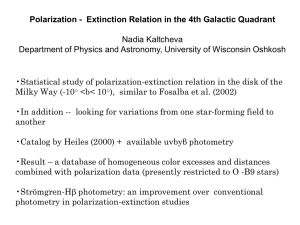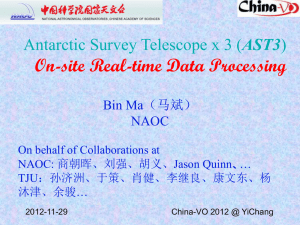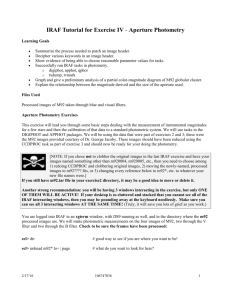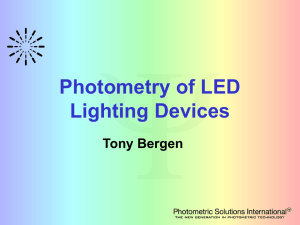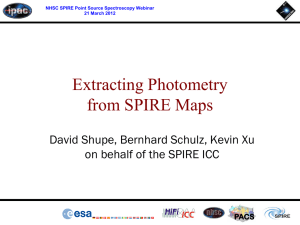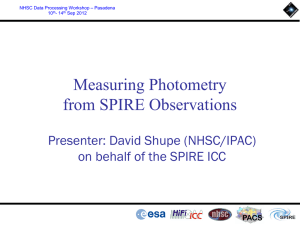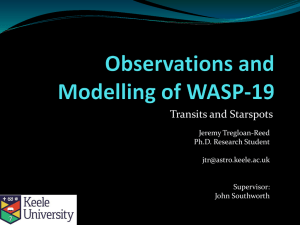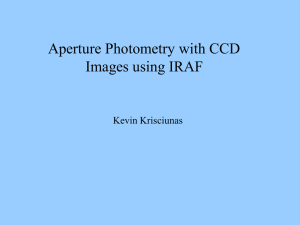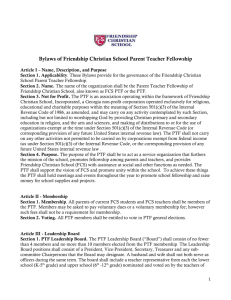Photometry and Astrometry -
advertisement
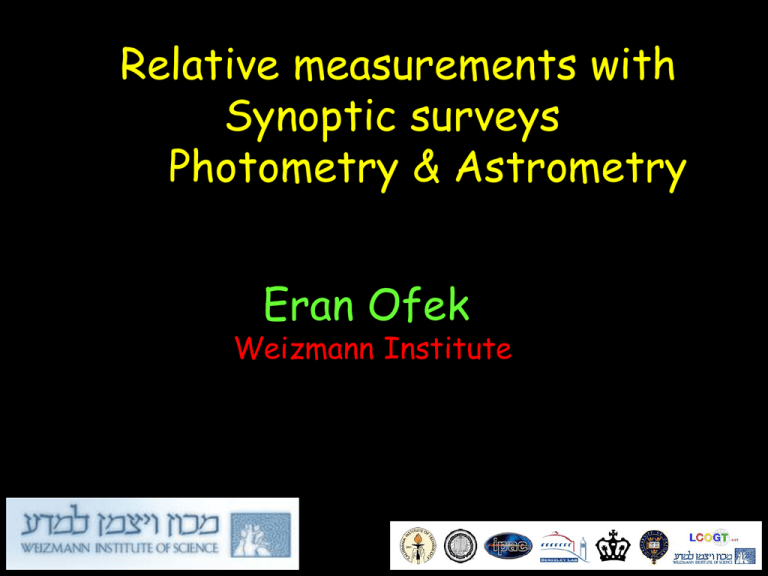
Relative measurements with Synoptic surveys I. Photometry & Astrometry Eran Ofek Weizmann Institute Talk Layout Motivation and science case Relative photometry Limiting factors Methods Linear regression Relative astrometry Effects and limiting factors Methods and results Motivation Relative photometry Light curves Spectral energy distribution Precision driver: small variations Relative astrometry Proper motions, parallax, binarity Photometry and astrometry have much in common Light curves Some eclipsing M-dwarfs in PTF Poolishok et al. 2012 Asteroids rotation Poolishok et al. 2012 Asteroids rotation Photometry How? Aperture photometry e.g., phot, SExtrator PSF photometry e.g., daophot, dophot Galaxy fitting e.g., GalFit Absolute (Calibrated) Relative Photometry Aperture photometry Summing the intensity within an aperture Complications: Subtracting the background Interpolating Optimal aperture Centering Aperture photometry Interpolating Solution: Bickerton & Lupton 2013 Fraction of light Aperture photometry S/N Optimal aperture Aper Radius [pix] Aperture photometry S/N Fraction of light Biases S/N S/N Biases may influence photometry, mainly At the faint end (e.g., due to uncertainty in position) Aper Radius [pix] Calibrated photometry Methods Calibrate the apparatus (but atmosphere) Local standard stars Global standard stars E.g., CalibMag = InstMag + ZP + … aAM + b color + c AM color + … time…, CCD position, atmo cond,… Calibrated photometry Photometry calibration good to 2-3% Ofek et al. 2012a,b CCD 4 Calibrated photometry Ofek et al. 2011 submitted Photometry calibration good to 2-3% Using SDSS stars as standard stars to calibrate fields outside SDSS footprint (photometric nights) CCD 4 Relative photometry Find the ZP per image to add to magnitudes such that the scatter in the Light curves is minimized Relative photometry The ensemble method Everett & Howell (2001) Solving per field i-star (1..p), j-image (1..q) fij – instrumental flux sij – instrumental flux err Normalize by the ensamble: Caveats: requires stars that appears in all images + multiple iterations Relative photometry & LSQ Linear least squares – a reminder see a nice review in Gould (2003; arXiv/0310577) 1 T 2 c (mij HP) s ij (mij HP) 2 Relative photometry Solution using linear least squares Linear least squares – a reminder However, sometime inversion is hard… For large sets of equations use conjugate gradient Relative photometry Solution using linear least squares Honeycutt (1992); Padmanabhan et al. (2007); Ofek et al. (2011) Solving per field (overlap between fields not guaranteed) i-star (1..p), j-image (1..q) mij – instrumental mag sij – instrumental mag err mij m j zi Relative photometry m m z ij j i Using linear least squares z <m> 0 0 1 0 0 0 0 1 m11 m12 P m13 0 1 0 1 0 0 m21 0 1 0 0 1 0 1 0 0 0 0 1 m22 m23 zj P mi ? ? ? H (“design matrix”) Observations Free parameters 1 0 0 1 0 1 0 0 0 1 Relative photometry Simultaneous absolute calibration 1 0 0 1 0 1 0 0 0 1 0 0 1 0 0 0 0 1 m11 m12 P m13 0 1 0 1 0 0 m21 0 1 0 0 1 0 1 0 0 0 0 1 m22 m23 H is (pq)x(p+q) matrix However, rank is p+q-1 0 0 0 0 0 0 0 0 0 1 0 0 0 1 0 0 0 1 M1 Mj Adding calibration block Relative photometry Additional de-trending We can add more columns to H and P. For example: obs m b Airmass x color term Positional terms Multiple CCDs (i.e, overlap) – ubercal (SDSS; PS1; LSST) Relative photometry Method presented in: Ofek et al. 2011 ApJ 740, 65 Relative photometry ~3-5mmag Relative photometry Limiting factors Poisson statistics Flat fielding Charge diffusion variations Atmospheric intensity scintilations Relative photometry Limiting factors Flat Credit: Malagon (BNL) Astrometry Motivation Relating objects… Is a transient associated with gal. nuc.? Searching for SN progenitors Proper motions Parallaxes Binarity Motivation Example 1 1 3 10 30 100 1 3 10 30 300 100 100 1 1000 10 300 Astrometric amplitude of 10kK WD-WD binary at 14-18 mag range 0.3 3 10 30 100 300 0 Period [yr] 10 1000 0 .3 0.1 0.1 10 −1 0.1 1 0.3 10 −2 10 0 10 1 10 2 Distance [pc] 10 3 10 4 State of the art Best proper motions available: Hipparcos: ~0.25 (1σ) mas/yr (V<9) PS-1/MDS ~10mas/yr (1σ) Tonry+2012 USNO-B vs. SDSS (+): ~6 mas/yr (1σ) GAIA… Large field of view What effects astrometry? Relative astrometry Limitations However… Large field of view Field distortion Precession/Nutation Atmospheric refraction Color dependent refraction Abberation of light Light deflection Scintillations Centeroiding Large field of view Atmospheric refraction Large field of view Light Deflection Light Deflection Large field of view Differential Light difl. Light Deflection Large field of view Distortions ~1”/deg Precession >3”/yr Refraction ~1-2”/deg Color Ref. Abberation Deflection Scintillations Centeroiding ~80mas/500Å ~0.5”/deg ~0.1mas/deg 2”/√(60 x 100)~25mas ? <20 mas Stratergies for PTF PTF deep coadd vs. SDSS good for faint stars ~10 mas/yr Use PTF multiple epochs beat scintillation noise using √N Periodicity in the residuals… Binaries Search for proper motion stars Comparing PTF deep coadd with SDSS Search for proper motion stars Comparing PTF deep coadd with SDSS Search for proper motion stars Comparing PTF deep coadd with SDSS Search for proper motion stars Comparing PTF deep coadd with SDSS Stratergies for PTF PTF deep coadd vs. SDSS good for faint stars ~10 mas/yr Use PTF multiple epochs beat scintillation noise using √N Periodicity in the residuals… Binaries Metodology i – image, j - star Xij – (abb…) = DXi + <X>j + Xij cos(Θi) – Yij sin( i) + … ai Xij2 + bi Yij2 + … (distortions per image) c Xj2 + d Yj2 + … (distortion per set of images) ei AMij sin(Qij) + fi AMij Colorj sin(Qij) + … g (Xij – floor(Xij)) + … (sys. Center. Errors) (proper motion) + (parallax) + … Yij – (abb…) = … Produce: ~107 equations with ~30,000 unknowns (single field/ccd) Relative astrometry Ofek & Gorbikov Preliminary results Preliminary results Relative astrometry Ofek & Gorbikov Summary Relative photometry 0.5-1 mmag precision is possible using ground based observation Relative astrometry Sub-mas precision is possible using (nonAO) ground based observations. Both – requires excellent understanding of systematic effects. Tips: explore the residuals End Thank you! Preliminary results Preliminary results Absolute astrometry Limitations Abs. astrometry In PTF IPAC pipeline images Reference catalogs: SDSS or UCAC-3 or USNO-B1 (in SCAMP) or USNO-B1 (in Astrometry.NET) Abs. astrometry In PTF IPAC pipeline images Abs. astrometry In PTF IPAC pipeline images Search for proper motion stars Comparing PTF deep coadd with SDSS Advantage: deeper than previous surveys Search for proper motion stars PM[“/yr] = V[km/s] / (4.74 d[pc]) Reduced Proper motion H=M+5 log10(V)–3.379 = m–5 log10(PM)
